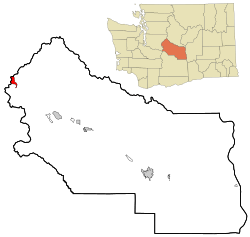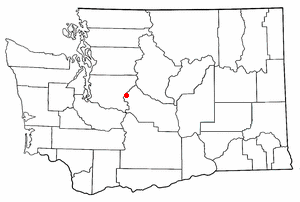Snoqualmie Pass, Washington facts for kids
Quick facts for kids
Snoqualmie Pass, Washington
|
|
|---|---|

Location of Snoqualmie Pass, Washington
|
|
| Country | United States |
| State | Washington |
| County | Kittitas |
| Area | |
| • Total | 2.93 sq mi (7.58 km2) |
| • Land | 2.93 sq mi (7.58 km2) |
| • Water | 0 sq mi (0.0 km2) |
| Elevation | 2,726 ft (831 m) |
| Population
(2020)
|
|
| • Total | 372 |
| • Density | 127.11/sq mi (49.08/km2) |
| Time zone | UTC-8 (Pacific (PST)) |
| • Summer (DST) | UTC-7 (PDT) |
| ZIP code |
98068
|
| Area code(s) | 425 |
| FIPS code | 53-65275 |
| GNIS feature ID | 1852958 |
Snoqualmie Pass is a small community in Kittitas County, Washington, United States. It is known as a census-designated place (CDP). This means it's an area identified by the U.S. Census Bureau for statistics. The community also includes the area called Hyak. In 2020, about 372 people lived here.
The community gets its name from the mountain pass it sits on. This pass is where Interstate 90 crosses the Cascade Range mountains. The pass itself is named after the Snoqualmie tribe. They are a Native American tribe who originally lived in the Snoqualmie Valley, which is west of the pass. The part of the mountain pass in King County, to the west, is not part of this community.
Snoqualmie Pass is a wealthy area. It ranks very high for income per person in Washington state.
Contents
Fun Things to Do in Snoqualmie Pass
Snoqualmie Pass is a popular spot for outdoor fun. Many of the homes here are mountain chalets and condos. People from the Seattle metropolitan area often use them for vacations. About 300 people live here all year. While winter sports are the biggest draw, you can find outdoor activities all year long.
Hiking and Trails
The famous Pacific Crest Trail goes right through Snoqualmie Pass. There are many other trails for hiking and climbing in the summer. In winter, these trails are great for cross-country skiing and snowshoeing.
Skiing and Snow Sports
Snoqualmie Pass is home to the Summit at Snoqualmie. This is a group of alpine ski areas run by Boyne USA Resorts. The Summit has four main ski areas:
- Alpental
- Summit West (used to be Snoqualmie Summit)
- Summit Central (used to be Ski Acres)
- Summit East (used to be Hyak)
The Summit at Snoqualmie is the closest ski area to Seattle. This means it can get very busy on weekends!
Iron Horse State Park in Hyak offers more winter fun. You can find groomed trails for cross-country skiing, sledding, and snowshoeing there. In the summer, the park's gravel railroad bed is perfect for hiking and bicycling.
Other Outdoor Adventures
Snowmobiling is also very popular just east of the pass during winter. In the summer and fall, you might see paragliders and hang gliders flying high above the valley. They often land near Lake Keechelus.
Where is Snoqualmie Pass?
The community is in the very western part of Kittitas County. It sits on the east side of Snoqualmie Pass. Its western edge is the border with King County. This border is also the highest point of the Cascade Range mountains. The community stretches southeast to Keechelus Lake, which is where the Yakima River begins. The small community of Hyak is in the southeast part of Snoqualmie Pass.
Interstate 90 runs through the community. You can get on and off I-90 at Exits 53 and 54. I-90 goes west about 53 miles (85 km) to Seattle. It goes southeast the same distance to Ellensburg, which is the main town in Kittitas County. Washington State Route 906 is a local road that goes through Snoqualmie Pass. It connects to I-90 at both exits.
Snoqualmie Pass covers about 7.6 square kilometers (2.9 square miles) of land. It's an important spot in the Cascade Range. The community is part of the Mountains to Sound Greenway. This is a special area that includes parts of King and Kittitas counties. The eastern entrance of the 2.2-mile (3.5 km) long Snoqualmie Tunnel is in Hyak, within the community.
Weather in Snoqualmie Pass
Snoqualmie Pass is high up in the mountains. This means it has much colder temperatures than Seattle. It also gets a lot more rain and snow. Snoqualmie Pass has a type of climate with cold, very wet, and snowy winters. Summers are mild to warm and fairly dry.
| Climate data for Snoqualmie Pass, Washington, (1915–1972 normals and extremes) | |||||||||||||
|---|---|---|---|---|---|---|---|---|---|---|---|---|---|
| Month | Jan | Feb | Mar | Apr | May | Jun | Jul | Aug | Sep | Oct | Nov | Dec | Year |
| Record high °F (°C) | 56 (13) |
61 (16) |
69 (21) |
81 (27) |
84 (29) |
94 (34) |
101 (38) |
98 (37) |
101 (38) |
88 (31) |
65 (18) |
53 (12) |
101 (38) |
| Mean maximum °F (°C) | 44.0 (6.7) |
47.8 (8.8) |
55.2 (12.9) |
65.1 (18.4) |
74.2 (23.4) |
81.3 (27.4) |
86.6 (30.3) |
85.4 (29.7) |
81.0 (27.2) |
70.7 (21.5) |
52.2 (11.2) |
45.0 (7.2) |
88.3 (31.3) |
| Mean daily maximum °F (°C) | 32.4 (0.2) |
37.4 (3.0) |
42.6 (5.9) |
49.0 (9.4) |
56.5 (13.6) |
63.0 (17.2) |
70.3 (21.3) |
69.6 (20.9) |
63.9 (17.7) |
53.9 (12.2) |
40.1 (4.5) |
33.9 (1.1) |
51.0 (10.6) |
| Daily mean °F (°C) | 26.6 (−3.0) |
30.4 (−0.9) |
34.3 (1.3) |
39.5 (4.2) |
45.3 (7.4) |
51.4 (10.8) |
57.8 (14.3) |
57.5 (14.2) |
52.4 (11.3) |
44.4 (6.9) |
34.2 (1.2) |
28.6 (−1.9) |
41.9 (5.5) |
| Mean daily minimum °F (°C) | 20.9 (−6.2) |
23.3 (−4.8) |
26.0 (−3.3) |
30.0 (−1.1) |
34.2 (1.2) |
40.0 (4.4) |
45.6 (7.6) |
45.7 (7.6) |
41.1 (5.1) |
35.0 (1.7) |
28.2 (−2.1) |
23.5 (−4.7) |
32.8 (0.4) |
| Mean minimum °F (°C) | 2.3 (−16.5) |
7.6 (−13.6) |
13.1 (−10.5) |
20.3 (−6.5) |
26.5 (−3.1) |
33.0 (0.6) |
36.7 (2.6) |
37.0 (2.8) |
30.5 (−0.8) |
24.9 (−3.9) |
16.8 (−8.4) |
8.1 (−13.3) |
−2.3 (−19.1) |
| Record low °F (°C) | −17 (−27) |
−15 (−26) |
0 (−18) |
7 (−14) |
16 (−9) |
27 (−3) |
30 (−1) |
27 (−3) |
22 (−6) |
11 (−12) |
0 (−18) |
−19 (−28) |
−19 (−28) |
| Average precipitation inches (mm) | 15.44 (392) |
11.33 (288) |
10.37 (263) |
5.87 (149) |
3.86 (98) |
3.70 (94) |
1.37 (35) |
2.14 (54) |
4.56 (116) |
8.98 (228) |
13.17 (335) |
16.72 (425) |
97.51 (2,477) |
| Average snowfall inches (cm) | 100.8 (256) |
72.4 (184) |
66.3 (168) |
24.0 (61) |
5.2 (13) |
0.3 (0.76) |
0.0 (0.0) |
0.0 (0.0) |
0.1 (0.25) |
6.6 (17) |
39.9 (101) |
83.9 (213) |
399.5 (1,014.01) |
| Average extreme snow depth inches (cm) | 92 (230) |
109 (280) |
110 (280) |
91 (230) |
57 (140) |
9 (23) |
0 (0) |
0 (0) |
0 (0) |
4 (10) |
25 (64) |
61 (150) |
120 (300) |
| Average precipitation days (≥ 0.01 in) | 18.8 | 15.8 | 17.4 | 13.9 | 11.3 | 10.1 | 5.0 | 6.4 | 9.1 | 12.8 | 16.2 | 19.9 | 156.7 |
| Average snowy days (≥ 0.1 in) | 15.8 | 11.9 | 11.6 | 5.7 | 1.6 | 0.1 | 0.0 | 0.0 | 0.0 | 1.8 | 8.2 | 14.5 | 71.2 |
| Average relative humidity (%) | 93 | 93 | 91 | 86 | 80 | 76 | 69 | 70 | 75 | 81 | 89 | 92 | 83 |
| Mean daily sunshine hours | 3.0 | 3.0 | 4.3 | 6.5 | 8.4 | 9.4 | 10.7 | 10.9 | 8.7 | 5.1 | 3.8 | 3.1 | 6.4 |
| Mean daily daylight hours | 9.0 | 10.3 | 12.0 | 13.7 | 15.1 | 15.9 | 15.5 | 14.2 | 12.5 | 10.8 | 9.3 | 8.5 | 12.2 |
| Average ultraviolet index | 1 | 1 | 2 | 2 | 3 | 4 | 5 | 3 | 2 | 2 | 1 | 1 | 2 |
| Source 1: XMACIS (temps 1915–1972, precip/precip days 1912–2000, snow/snow days 1910–2002) | |||||||||||||
| Source 2: Weather Atlas (UV and humidity) | |||||||||||||
Who Lives in Snoqualmie Pass?
| Historical population | |||
|---|---|---|---|
| Census | Pop. | %± | |
| 2000 | 201 | — | |
| 2010 | 311 | 54.7% | |
| 2020 | 372 | 19.6% | |
In 2000, there were 201 people living in Snoqualmie Pass. They lived in 88 households, and 60 of these were families. The area had about 70 people per square mile (27 per km2). Most people (93.03%) were White. A small number were Asian (1.00%), Pacific Islander (1.00%), or from two or more races (4.98%). About 0.50% of the people were Hispanic or Latino.
About 23.9% of households had children under 18. Most households (61.4%) were married couples. About 21.6% of households were single people. Only 2.3% of households had someone living alone who was 65 or older. The average household had 2.28 people, and the average family had 2.68 people.
The population was spread out by age. About 18.9% were under 18. About 37.3% were between 25 and 44 years old. The median age was 40 years. For every 100 females, there were about 109 males.
The average income for a household was $81,883. For families, it was $89,532. The income per person was $54,316. Very few families or people lived below the poverty line.
See also
 In Spanish: Snoqualmie Pass (Washington) para niños
In Spanish: Snoqualmie Pass (Washington) para niños


